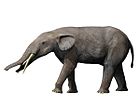Chilgatherium
| Chilgatherium Temporal range: Late Oligocene
| |
|---|---|

| |
| Scientific classification | |
| Domain: | Eukaryota |
| Kingdom: | Animalia |
| Phylum: | Chordata |
| Class: | Mammalia |
| Order: | Proboscidea |
| Family: | †Deinotheriidae |
| Subfamily: | †Chilgatheriinae Sanders, Kappelman, & Rasmussen, 2004 |
| Genus: | †Chilgatherium Sanders, Kappelman, & Rasmussen, 2004 |
| Species: | †C. harrisi
|
| Binomial name | |
| †Chilgatherium harrisi | |
Chilgatherium ('Chilga beast' after the locality in which it was found) is the earliest and most primitive representative of the family Deinotheriidae.[1] It is known from late Oligocene (27- to 28-million-year-old) fossil teeth found in the Ethiopian district of Chilga.
So far, only a few molar teeth have been found, but these are distinct enough that this animal can be identified with confidence. The teeth differ from those of Prodeinotherium, Deinotherium, and the various barytheres in various details, enough to show that this is a distinct type of animal, and has been placed in its own subfamily. Compared to later deinotheres, Chilgatherium was quite small, about 2 m (6.6 ft) tall at the shoulder and weighed about 1.5 t (1.7 short tons).[2] It is not known if it shared the distinctive downward-curving tusks on the lower jaw that the later deinotheres had.
Chilgatherium disappeared prior to the Early Miocene, when it was replaced by Prodeinotherium.
References
[edit]- ^ Athanassios Athanassiou (November 2004). "On a Deinotherium (Proboscidea) finding in the Neogene of Crete". Carnets de géologie (Notebooks on geology). 5: 1–7. doi:10.4267/2042/311.
- ^ Larramendi, A. (2016). "Shoulder height, body mass and shape of proboscideans" (PDF). Acta Palaeontologica Polonica. 61. doi:10.4202/app.00136.2014.
Further reading
[edit]- Gugliotta, Guy (2003) Six New Species of Prehistoric Mammals Discovered in Africa Find Proves Elephants Originated on Continent, Scientist Says, The Washington Post, Thursday, December 4, 2003; Page A02
- Sanders, W.J., Kappelman, J. & Rasmussen, D. T. (2004). "New large-bodied mammals from the late Oligocene site of Chilga, Ethiopia" (PDF). Acta Palaeontologica Polonica. 49 (3): 365–392. Archived from the original (PDF) on 2005-05-29. Retrieved 2019-06-30.
{{cite journal}}: CS1 maint: multiple names: authors list (link)



